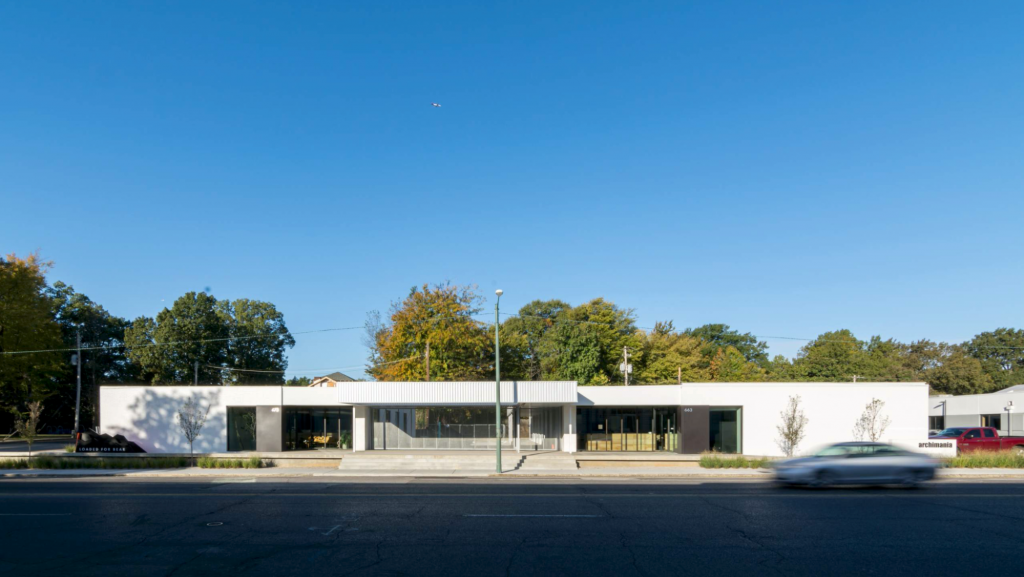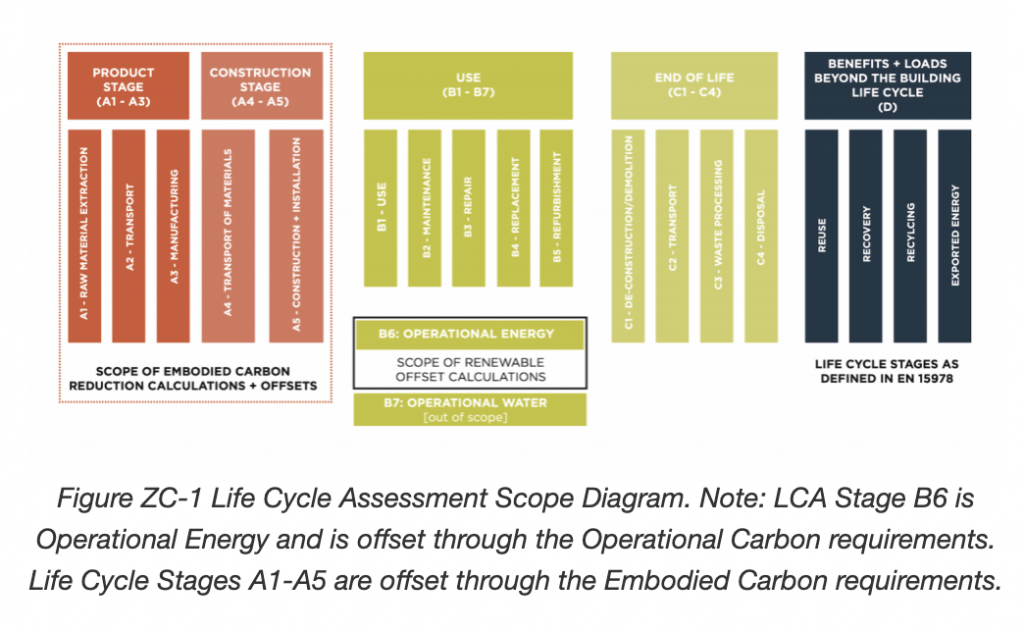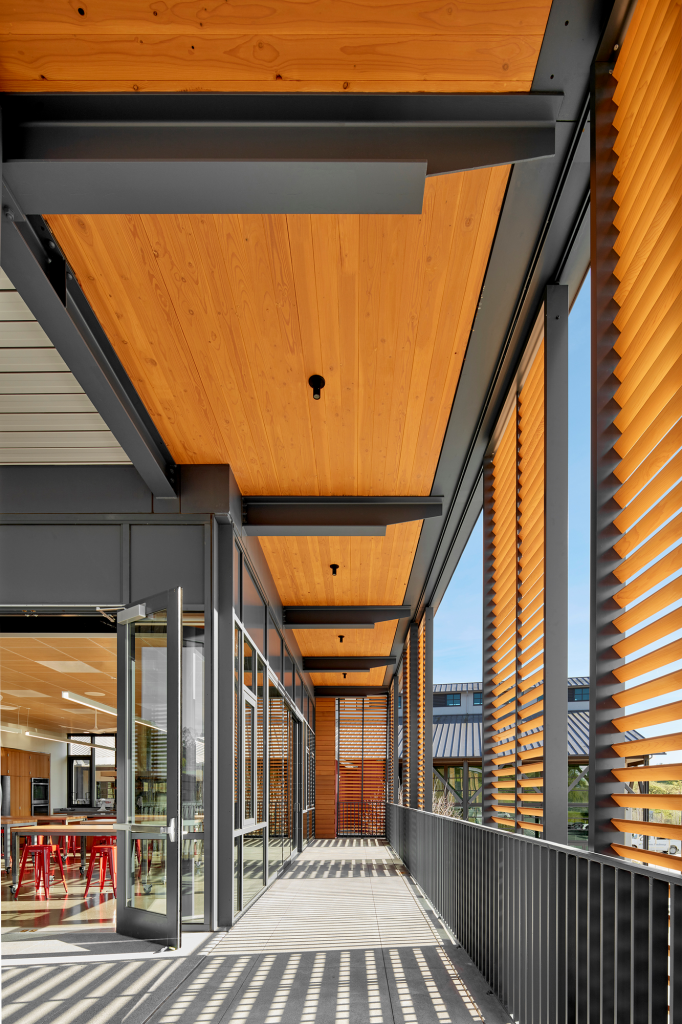Authors note: Embodied carbon is now part of the Declare label! To learn more about embodied carbon and the Zero Carbon Certification read below and contact us at zc.support@living-future.org.
In recent decades the building sector’s focus on creating energy-efficient buildings run by renewable energy has been essential in pushing the building industry towards more sustainable practices. We believe the building industry is ready to take it further by increasing efforts to reduce a building’s embodied carbon. The greenhouse gas emissions associated with the extraction, manufacturing, and transport of building materials to the construction site. As buildings become more energy-efficient and energy mixes become more weighted towards renewables, the upfront embodied carbon impacts from materials still account for a large portion of a building’s carbon footprint and will grow in the portion of overall emissions tied to buildings. This reference guide shares some general tips on how practitioners can address embodied carbon at three key project stages: pre-design, design, and construction. It aims to share key process elements that project teams should consider at each building phase, additional resources, and examples to highlight the possibility and great potential for carbon-neutral buildings.
Pre-Design and Schematic Design
Pre-design sets the stage for the entire project and is an excellent opportunity to introduce carbon reduction targets. In addition to informing decisions related to site analysis, budgeting, and programming use requirements, having specific reduction goals establishes a clear and uniform vision amongst a team of developers, designers, architects, and engineers. To help set those targets, explore relevant regulations and rating systems such as ILFI’s Living Building Challenge, Core Green Building Certification, and the Zero Carbon Program to help create a framework.
“Architects can often make large embodied carbon reductions with cost-neutral measures. A 2021 report from RMI found that case studies had embodied carbon savings of 24–46% at cost premiums of less than 1%. Even greater reductions can be achieved through prioritizing design strategies early in a project to reduce embodied carbon.”
Carbon Leadership Forum
The pre-design stage generally includes a site analysis, one of the first opportunities to reduce emissions. For new construction, consider building on previously developed sites that have existing infrastructure and highlight other efforts to preserve and contribute positively to the site’s ecology. Think about restoring undeveloped portions of the area with native vegetation and other actions to support a healthy ecological site. In addition, observe and take inventory of any existing structures or in situ materials that have the potential for reuse that can be used for the project or donated to salvage stores for other projects to use.
Reuse was integral to the archimania 663 South Cooper Street corridor, a certified Zero Carbon and Zero Energy project in Memphis, Tennessee, USA. With a focus on place, energy efficiency, and carbon neutrality, the team demonstrated the potential for carbon-neutral and human-centered commercial districts through intentional design and reuse.
“By upcycling the existing concrete and terrazzo floor, steel structure, and exterior masonry, while incorporating new materials with high recycled content and/or locally sourced, we were able to reduce the embodied carbon by 67% from a conventional new build. By reducing the operational energy demand with a geothermal HVAC system, lighting controls, and daylight harvesting, the 50kW rooftop solar array more than offset the power demand. Collectively, archimania’s investment in energy-saving strategies have produced a net return on investment in less than 10 years – defying conventional developer logic. As we look ahead, the research-driven process and data being produced provide insight into how sustainable strategies can be scaled across a wide range of building sizes and typologies in both existing and new construction. We are currently expanding our case study and proof-of-concept to understand the impact that these results could have along a 2-mile “Carbon Neutral Corridor,” with projected impact equal to removing 8,000 cars off the street annually or powering 4,000 homes each year.” – Jacob Davis, AIA, LEED AP, and Senior Associate at archimania

Learn more about the project here.
Design Development
The design stage is an opportunity to lay out key reduction strategies, select materials, and finalize the building systems and assemblies.
The first activity is to conduct an iterative embodied carbon assessment. Whole Building Life cycle assessments (LCA) are used for tracking and benchmarking the environmental impacts of a building. Select a life cycle assessment tool or calculator that sources data from verified third-party information such as Environmental Product Declarations (EPDs) or a peer-reviewed LCA. In addition, select a tool that sources embodied carbon data from the relevant region and can conduct a complete cradle-to-grave analysis as defined by ISO 14044. Several tools are available for projects to do a full life cycle assessment. Teams can find a list of ILFI-approved tools in the Zero Carbon Handbook. Using an LCA, the team can calculate the project’s baseline, identify hot spots (materials or assemblies with the highest carbon intensities), and test for lower carbon design options or material alternatives. To achieve Zero Carbon certification, projects must, at minimum, account for the embodied carbon impacts of the production and construction stage (A1-A5) and demonstrate a 10% reduction in embodied carbon (A1-A5) of primary materials. Learn more about Zero Carbon standard requirements here.

With the help of the whole building LCA, the team will establish strategies for reducing materials with the most significant impact and collaborate to configure the best assemblies to minimize the impact of structural hotspots. The Carbon Leadership Forum (CLF) has several toolkits and resources highlighting embodied carbon reduction strategies, such as The Embodied Carbon Toolkit for Architects. This toolkit includes Strategies for Reducing Embodied Carbon. Below are some highlighted methods;
- Material Alternatives. Using low carbon structural materials and carbon sequestering materials helps avoid emissions associated with manufacturing new materials. Carbon Smart Materials, a project of Architecture 2030, shares material-specific strategies to achieve embodied carbon reductions.
- Material Quantity Reduction. Reusing materials is excellent for your climate goals and your wallet. Use in-situ materials the team identified as appropriate for reuse in your site analysis. Also, consider prefabricated construction as a key design strategy.
- Product Alternative. Select products that are highly durable and have a long service life. Consider locally sourced products to reduce transportation costs and emissions and select sustainably harvested materials with third-party verification.
The Sonoma Academy, located in Santa Rosa, CA, was the first project to achieve Zero Carbon certification in California. With a focus on wellness, sustainability, and innovation the project design included low-carbon earth blocks for cladding, reclaimed beams, and locally sourced reclaimed wood to reduce material transportation costs. The team also addressed the site’s ecology with a living roof that connects to tiered planters that filters greywater and stormwater for reuse. Learn more about the project here.
“Resource management and material health have always been a key consideration of our design process and Sonoma Academy’s detailed vision for environmental stewardship. With the critical overlay of embodied carbon, our effect on communities around the globe is magnified and we need to see this as an opportunity to design better with what we already have. It brings the reality of region and reuse into high focus.”
Pauline Souza Director of Sustainability at WRNS

As mentioned earlier, Environmental Product Declarations are critical for understanding the environmental impacts of a material. If you notice materials do not have an EPD, request them from manufacturers. As more teams request for better quality EPDs that are accurate and current, the building industry can build its environmental impact database, and manufacturers will be incentivized to be more transparent with their products. Product-specific EPDs are the most valuable, as they provide granularity to product types where there may be a wide range of embodied carbon values. Doing so will ensure the team can find the best material options to meet their carbon targets. Check out the Building Transparency EC3 Tool, an advocacy tool aiming to provide open access data and tools to shift the building industry for greater product transparency. To grow this effort ILFI is happy to announce that embodied carbon is now included in the Declare label!
The materials used are critical but so is how you assemble them and design the overall building. As the team evaluates the size of the project, the team should aim to model flexibility and efficiency to reduce waste by reducing floor area and optimizing space for multipurpose use. The Google 6 Pancras Square is an excellent example of how lean design can support reduction targets. A key objective of the building was to create an adaptable space that can accommodate changing users and flexible working conditions. The team’s main strategies were to design for reuse, maximize recycled content, locally source materials and reuse appropriate existing building materials. Learn more about the project here.
Design for durability and longevity. Select materials that work best for your climate and are built to last. Consider techniques and assemblies that will help reduce the total amount of materials used, reduce new floor area, and prioritize lightweight, efficient structures. The Structural Engineering Institue (SEI) SE2050 is a group of structural engineers sharing resources and strategies for achieving net-zero embodied carbon structural systems.
While Zero Carbon primarily addresses embodied carbon associated with life cycle stages A1-A5 and the emissions associated with use stage B, ILFI encourages teams to examine a building’s end of life and to design for deconstruction and reuse. This will reduce waste and ultimately result in a greater supply of salvageable materials. This was one of the hallmarks of Google’s project, as interior space renovations can lead up to equivalent impacts to primary materials embodied carbon over time, even more, if renovations are particularly wasteful.

Construction Documents and Construction
During contracting and procurement, request products with a Type III Environmental Product Declaration (EPD), as defined by ISO Standard 14025, or equivalent. Finalize product procurement with materials with the lowest documented embodied carbon value and track optimizations through the submittal process.
At the time of construction, aim to reduce all waste. This could look like procuring only what is needed to avoid excess products and reduce packaging. Divert waste from landfills and consider strategies to ensure any potential waste is recycled when appropriate.
After taking inventory of all materials and product selections, conduct a final LCA to document the project’s total embodied carbon. In the final assessment, reflect on the differences between the design and the as-built LCA to help identify future strategies for your next Zero Carbon project. Finally, share the results with the community! Most importantly, share lessons learned throughout the process to highlight challenges other projects should consider and critical opportunities and decisions that supported the projects embodied carbon targets.
If you plan and set targets early, reducing embodied carbon doesn’t always come with high costs. The process will require a commitment from the whole team and will require the developer to ask the right questions from contractors and manufacturers. Having the correct data is key. Utilize LCA tools and EPDs to identify hotspots and compare design options to develop efficient building assemblies and specify low carbon and recycled materials.
The body of knowledge around regenerative design and carbon-neutral buildings is expanding. We want to hear from you! Join our community of practitioners and advocates with the goal of healthy, regenerative carbon-neutral buildings. Share lessons learned, challenges, and innovative strategies to reduce carbon impacts in our Member events and Member, discussion board. Or be a part of ILFIs Energy and Carbon Technical Advisory Group to share your expertise on how ILFIs programs can continue to lead building teams to achieve innovative energy and carbon solutions.
Resources
AIA -CLF Embodied Carbon Toolkit
Carbon Leadership Forum (CLF)
Carbon Smart Materials Palette
Cross Laminated Timber LCA Report
Embodied Carbon Guidance (ILFI)
Roadmap to Reducing Building Life Cycle Impacts
The Structural Engineering Institue (SEI) SE2050
The Living Building Challenge
Zero Carbon Program



